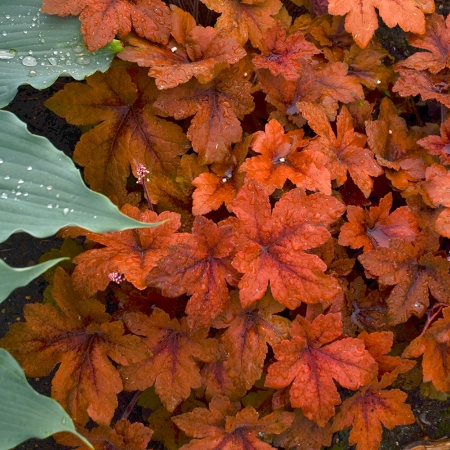Heucherella (Foamy Bells)
×
Color Name: Pumpkin Spice
Get a sweet taste of fall in spring with Pumpkin Spice! Bronze red leaves emerge in late spring and hold its color well into early summer. Each 4 inch lobed leaf has deep mahogany centers that follow the veins of the leaf. Dark red stems hold cream flowers that appear in early summer. For best foliage color and performance, plant in an area with filtered sun or afternoon shade.
Pumpkin Spice is a H. villosa hybrid which means that it is naturally more heat and humidity tolerant and also has greater vigor than Heucherellas without such parentage. It forms a very dense mound of interesting foliage that is evergreen in most climates.
Foamy bells are easy to grow and blend easily with most other perennials in the landscape. Because of their low, mounding habit, they are often used as edging along paths or in containers. Try cutting a few of the tall flower scapes for fresh bouquets.
Growing Tips: Heucheras are easy perennials to grow and fit nicely in the front of any border, rock garden, or container. They grow most vigorously and have the strongest colors when grown in partial shade (preferably afternoon shade). They can also be grown in full shade but their growth rate will be very slow. Some varieties can withstand full sun in northern climates if they have consistent moisture, but their colors tend to fade with the intensity of the sun. The soil should be amended with organic matter prior to planting. It should also have good drainage and a neutral pH.
Heucheras are evergreen in areas with mild winters. If properly sited out of the way of winter winds and with reliable snow cover, gardeners in northern regions may also find their heucheras acting as evergreens. If the plant looks tattered by early spring, shear off any damaged leaves to make room for the vibrant new foliage which will fill in quickly.
Heucheras can be grown under Black Walnut trees because they are resistant to the toxin Juglone which the trees emit from their roots.
Heucheras are also salt tolerant. They are useful in the north along pathways which are salted in winter or for people gardening in coastal regions. Occasionally in northern regions, heucheras have a tendency to heave out of the ground because of the freeze/thaw cycle. To combat heaving, add an extra layer of compost around the plant's roots in the fall. In the spring, if the plants have heaved at all, the new roots will grow into the fresh new layer of compost.
Photo courtesy of Walters Garden, Inc.
Get a sweet taste of fall in spring with Pumpkin Spice! Bronze red leaves emerge in late spring and hold its color well into early summer. Each 4 inch lobed leaf has deep mahogany centers that follow the veins of the leaf. Dark red stems hold cream flowers that appear in early summer. For best foliage color and performance, plant in an area with filtered sun or afternoon shade.
Pumpkin Spice is a H. villosa hybrid which means that it is naturally more heat and humidity tolerant and also has greater vigor than Heucherellas without such parentage. It forms a very dense mound of interesting foliage that is evergreen in most climates.
Foamy bells are easy to grow and blend easily with most other perennials in the landscape. Because of their low, mounding habit, they are often used as edging along paths or in containers. Try cutting a few of the tall flower scapes for fresh bouquets.
Growing Tips: Heucheras are easy perennials to grow and fit nicely in the front of any border, rock garden, or container. They grow most vigorously and have the strongest colors when grown in partial shade (preferably afternoon shade). They can also be grown in full shade but their growth rate will be very slow. Some varieties can withstand full sun in northern climates if they have consistent moisture, but their colors tend to fade with the intensity of the sun. The soil should be amended with organic matter prior to planting. It should also have good drainage and a neutral pH.
Heucheras are evergreen in areas with mild winters. If properly sited out of the way of winter winds and with reliable snow cover, gardeners in northern regions may also find their heucheras acting as evergreens. If the plant looks tattered by early spring, shear off any damaged leaves to make room for the vibrant new foliage which will fill in quickly.
Heucheras can be grown under Black Walnut trees because they are resistant to the toxin Juglone which the trees emit from their roots.
Heucheras are also salt tolerant. They are useful in the north along pathways which are salted in winter or for people gardening in coastal regions. Occasionally in northern regions, heucheras have a tendency to heave out of the ground because of the freeze/thaw cycle. To combat heaving, add an extra layer of compost around the plant's roots in the fall. In the spring, if the plants have heaved at all, the new roots will grow into the fresh new layer of compost.
Photo courtesy of Walters Garden, Inc.
|
Flower Color: Cream Shades Foliage Color: Bronze Shades
Height: 8 to 10 Inches Spread: 18 to 22 Inches Hardy in Zone: 4, 5, 6 |
Blooms: Late Spring / Early Summer
Foliage Season: All Year |
Growth Rate |
Medium
|
Attributes |
Native Container Landscapes Mass Planting Evergreen Easy to Grow Cut Flower or Foilage Colorful Foliage Border Salt Tolerant
|









